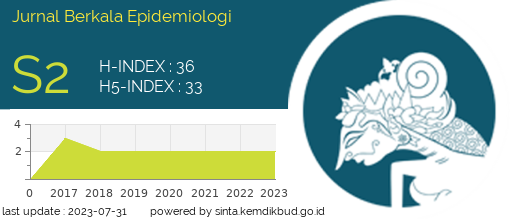Factors Associated with Abdominal Obesity in the Productive Age in Surabaya
Downloads
Obesity has become a problem in the health and nutrition of the world community. Abdominal obesity is more at risk of developing health problems such as diabetes mellitus, metabolic syndrome, hypertension, and cardiovascular disease than general obesity. Behavioral and environmental factors also genetic factors play a role in the onset of abdominal obesity. The purpose of this study was to analyze the factors associated with abdominal obesity at a productive age (15-64 years) in the city of Surabaya. The independent variables used were age, sex, marital status, family size, education, occupation, smoking habits, physical activity, consumption of vegetables and or fruits, sweet foods or drinks, fatty foods, and mental-emotional conditions. This research is analytic with cross-sectional design. The study uses secondary data from the Indonesia basic health research (Riskesdas) at 2007. The population taken was respondents in the city of Surabaya with a total sample of 2191 respondents which selected using simple random sampling. Data were analyzed by the Chi-square test and logistic regression. The analysis showed that risk factors for abdominal obesity were age 35-64 years, female sex, marital or divorced status, had educated at lower or equal as senior high school level, and regular consumption of fatty foods. Increasing knowledge, physical activity, and reducing fatty foods can prevent abdominal obesity.
Adiningrum, R.D., 2008. Karakteristik Kegemukan Pada Anak Sekolah dan Remaja di Medan dan Jakarta Selatan. Skripsi. Bogor: Fakultas Pertanian IPB.
Aekplakorn, W., Hogan M.C., Chongsuvivatwong V., Tatsanavivat P., Chariyalertsak S., Boonthum A., Tiptaradol S., dan Lim S.S., 2007. Trends in Obesity and Associations with Education and Urban or Rural Residence in Thailand. Obesity, 15: 3113-3121.
Al-Riyami, A. daa Afifi, M.M., 2003. Prevalence and Correlates of Obesity and Central Obesity Among Omani Adults. Saudi Med J, 24(6): 641-46.
Badan Penelitian dan Pengembangan Kesehatan Departemen Kesehatan RI., 2008. Laporan Riset Kesehatan Dasar Tahun 2007 Provinsi Jawa Timur. Jakarta; Balitbangkes Depkes RI: 46-49, 116-119.
Bray, G.A., Nielsen S.J., dan Popkin B.M., 2004. Consumption of High-Fructose Corn Syrup in Beverages May Play a Role in The Epidemic of Obesity. Am J Clin Nutr, 79: 537-543.
Canoy, D., Wareham N., Luben R., Welch A., Bingham S., Day N., dan Khaw K.T., 2005. Cigarette Smoking and Fat Distribution in 21,828 British Men and Women: a Population Based Study. Obes Res, 13: 1466-75.
Demerath, E.W., Sun S.S., Rogers N., Lee M., Reed D., Choh A.C., Couch W., Czerwinski S.A., Churnlea W.C., Siervogel R.M., dan Towne B., 2007. Anatomical Patterning of Visceral Adipose Tissue: Race, Sex, and Age Variation. Obesity, 15: 2984-2993.
Drapeau, V., Despres J.P., Bouchard C., Allard L., Fournier G., Leblanc C., dan Tremblay A., 2004. Modifications in Food-Group Consumption are Related to Long-Term Body-Weight Changes. Am J Clin Nutr, 80: 29-37.
Erem, C., Arslan C., Hacihasanoglu A., Deger O., Topbas M., Ukinc K., Ersoz H.O., dan Telatar M., 2004. Prevalence Of Obesity And Associated Risk Factors In A Turkish Population (Trabzon City, Turkey). Obes Res, 12: 1117-27.
Janghorbani, M., Amini M., Willett W.C., Mehdi Gouya M., Delavari A., Alikhani S., dan Mahdavi A., 2007. First Nationwide Survey of Prevalence of Overweight, Underweight, and Abdominal Obesity in Iranian Adults. Obesity, 15: 2797-2808.
Kantachuvessiri, A., Sirivichayakul C., KaewKungwal J., Tungtrongchitr R., dan Lotrakul M., 2005. Factors Associated with Obesity Among Workers in a Metropolitan Waterworks Authority. Southeast Asian J Trop Med Public Health, 36: 1057-65.
Koh-Banerjee, P., Chu N.F., Spiegelman D., Rosner B., Colditz G., Willett W., dan Rimm E., 2003. Prospective Study of The Association of Changes in Dietary Intake, Physical Activity, Alcohol Consumption, and Smoking with 9-Y Gain in Waist Circumference Among 16 587 US Men. Am J Clin Nutr, 78: 719-27.
Lee, E.S., Kim Y.H., Beck S.H., Lee S., dan Oh S.W., 2005. Depressive Mood and Abdominal Fat Distribution in Overweight Premenopausal Women. Obes Res, 13: 320-25.
Li, C., Ford E.S., McGuire L.C., dan Mokdad A.H., 2007. Increasing Trends in Waist Circumference and Abdominal Obesity Among U.S. Adults. Obesity, 15: 216-224.
Low, S., Chin M.C., dan Deurenberg-Yap M., 2009. Review on Epidemic of Obesity. Ann Acad Med Singapore, 38: 57-65.
Mustelin, L., Silventoinen K., Pietilainen K., Rissanen A., dan Kaprio J., 2009. Physical Activity Reduces The Influence of Genetic Effects on BMI and Waist Circumference: A Study in Young Adult Twins. Int J Obes, 33: 29-36.
Panagiotakos, D.B., Pitsavos C., Chrysohoou C., Risvas G., Kontogianni M.D., Zampelas A., dan Stefanadis C., 2004. Epidemiology of Overweight and Obesity in a Greek Adult Population: the ATTICA Study. Obes Res, 12: 1914-20.
Pusat Data dan Informasi Kementerian Kesehatan RI., 2013. Data dan Informasi Kesehatan Provinsi Jawa Timur. Jakarta: Pusdatin.
Soegondo, S., 2006. Buku Ajar Ilmu Penyakit Dalam. Jakarta: Pusat Penerbitan Ilmu Penyakit Dalam FKUI: 1941-5.
Sugianti, E., Hardinsyah, dan Nurfi A., 2009. Faktor Risiko Obesitas Sentral Pada Orang Dewasa Di DKI Jakarta. Gizi Indon, 32(2): 105-116.
WHO, 2000. Obesity: Preventing and Managing the Global Epidemic. Report of a WHO consultation. WHO. Geneva, Switzerland.
Wildman, R.P., Gu D., Reynolds K., Duan X., Wu X., dan He J., 2005. Are Waist Circumference and Body Mass Index Independently Associated With Cardiovascular Disease Risk in Chinese Adults?. Am J Clin Nutr, 82: 1195-202.
Wulandari, L., Edo, dan Manasye L.U., 2007. Dampak Obesitas Terhadap Faal Paru. Majalah Farmacia, 6: 8-9.
Yoon, Y.S., Oh S.W., dan Park H.S., 2006. Socioeconomic Status in Relation to Obesity and Abdominal Obesity in Korean Adults: a Focus on Sex Differences. Obesity, 14: 909-19.
- Every manuscript submitted to must observe the policy and terms set by the Jurnal Berkala Epidemiologi
- Publication rights to manuscript content published by the Jurnal Berkala Epidemiologi is owned by the journal with the consent and approval of the author(s) concerned. (download copyright agreement)
- Complete texts of electronically published manuscripts can be accessed free of charge if used for educational and research purposes according to copyright regulations.

JBE by Universitas Airlangga is licensed under a Creative Commons Attribution-ShareAlike 4.0 International License.























